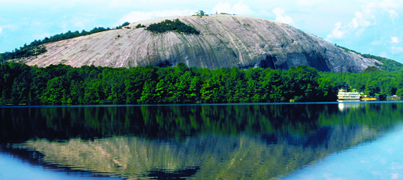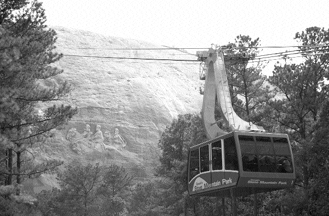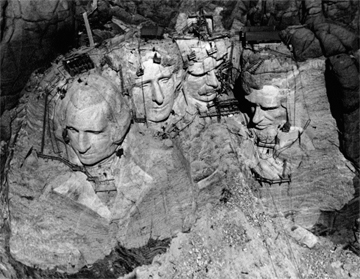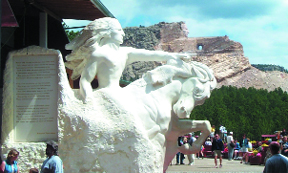Geotimes

Feature
Memorials in Stone
The summer is a wonderful time to hit the road and explore a variety of geologically
significant places. Here, we profile three stone features that have been transformed
into memorials to important figures in U.S. history — Confederate generals,
presidents and a Native American hero. These memorials stand as a tribute to the
regions’ rich geologic and cultural histories. For more travels in geology,
visit our Web feature at www.geotimes.org/Travels.html.
Memorial to the Old South
Two Monuments from One Stone
Memorial
to the Old South

Stone Mountain in Georgia is famous for the Confederate memorial carved into
its north face, which features Confederate President Jefferson Davis, General
Robert E. Lee and General Stonewall Jackson, each on horseback. The sculpture,
completed in the early 1970s, covers three acres of exposed granite. And, though
it is actually larger than the carved part of Mount Rushmore, the memorial is
dwarfed by the amount of granite the sculptors left behind — 7.5 billion
cubic feet covering 538 acres.
Located 16 miles east of Atlanta, Ga.,
Stone Mountain is about 540 acres of granite that rises more than 700 feet above
ground. Courtesy of Stone Mountain Park.
Stone Mountain is a monadnock, a remnant of resistant rock that withstood the
forces of weathering and erosion that denuded the terrain around it for millions
of years. From its base, it rises more than 700 feet above the surrounding 3,200
acres of Stone Mountain Park. The peak, at 1,686 feet above sea level, affords
views of up to 45 miles on a clear day, including vistas of the Blue Ridge Mountains
to the northwest and of Atlanta, 16 miles to the west. Likewise, the mountain
is visible from miles away.
“You rarely find outcrops that are this large and this spectacular,”
says Pamela Gore, a professor of geology at Georgia Perimeter College in Clarkston,
about 5 miles from Stone Mountain.
The behemoth lump of granite formed when magma intruded several miles below
the surface during the collision of the North American and African continents
that formed the Appalachian Mountains. Although the granite cooled about 300
million years ago, the rock did not see the light of day until uplift and erosion
uncovered it 15 million years ago.
This uncovering is the cause of Stone mountain’s domed shape. As erosion
removed the overlying rock burden, pressure was released and the outermost layers
began to expand and fracture. The rock then peeled from the surface in concentric
onion-like layers in a process called exfoliation, which continues today.
The carvers of the Confederate memorial took advantage of a similar process
using a tool called a thermo-jet torch (also used on parts of Crazy Horse; see
page 35). “This was like man-made exfoliation,” Gore says. “You
heat it, the rock expands, and then it just pops off in chunks. It wasn’t
done with a hammer and chisel, but with a torch.” The torches allowed carvers
to remove tons of granite per day.
Although the idea for the memorial was conceived of in 1915, and initial blasting
and carving began in the 1920s, work on the sculpture stopped due to lack of
funds and did not start up again until the mid-1960s, after the state had purchased
the land. It then took six years of carving with the thermo-jet torches to complete
the sculpture, which was officially dedicated in May 1970.
 Visitors can
see the mountain up close by ascending the 1.3-mile walking trail. Along the
trail, look for Civil War-era graffiti — names and dates carved into the
stone by visitors who wanted to leave their mark on this ancient place. Gore
says these are not only a fascinating peek at the past, but also well-dated
examples with which to demonstrate the effects of weathering over time.
Visitors can
see the mountain up close by ascending the 1.3-mile walking trail. Along the
trail, look for Civil War-era graffiti — names and dates carved into the
stone by visitors who wanted to leave their mark on this ancient place. Gore
says these are not only a fascinating peek at the past, but also well-dated
examples with which to demonstrate the effects of weathering over time.
A tram takes visitors to the top of Stone
Mountain in Georgia and gives them a close-up view of the memorial carved into
the granite — Confederate President Jefferson Davis and generals Robert
E. Lee and Stonewall Jackson, each on horseback. Courtesy of Stone Mountain
Park.
Near the summit, visitors can see depressions in the rock called solution pits,
which were caused by the exfoliation. These small hollows fill with water and
can support tiny ecosystems, including two federally protected species of aquatic
plants and a species of tiny clam shrimp.
Other interesting features of granite-outcrop ecology include the hardy lichens,
mosses, sedges, shrubs and stubby pine trees that are able to take root in the
shallow soil on the mountain’s rugged face. The high winds and temperature
extremes also support desert plants. “A lot of people think of Stone Mountain
as being a bald mountain,” says Kerrie Anne Loyd, the education supervisor
at the park, “but there is plant life.”
Visitors can learn more about the flora, fauna and geology of the park at the
new education center inside the recently renovated Confederate Hall at the base
of the walking trail. “Our major focus here is science,” Loyd says.
“There are a lot of interactive exhibits that interpret not only how the
mountain formed and what it’s made of, but also the geologic features you
see on it — things like dikes and weathering and tourmaline pods.”
For those interested in the human history of the site, the East Quarry features
an outdoor exhibit center. Granite quarrying began here around the time of the
Civil War and, over the next 130 years, an estimated 7.5 million cubic feet
of rock were removed for use around the country. The exhibit details the process
of quarrying and the technological advances made over the years, as well as
how the stone was worked and used.
Additionally, the park offers many other attractions, including a history museum,
the SkyLift tram to the summit, an antebellum plantation and farmyard, a scenic
railroad, an antique car museum, pedal boats on the lake, mini-golf, a water-slide
complex and laser shows under the memorial carving. “When you combine the
natural setting along with our attraction areas,” says Christine Parker,
public relations manager at the park, “there’s something for just
about everybody.”
Sara Pratt
Geotimes contributing writer
Links:
Stone
Mountain Memorial Association
Virtual
Geology Field Trip by Pamela Gore, Georgia Perimeter College
Back to top
Two
Monuments from One Stone
From a massive body of granite in South
Dakota came two of the world’s renowned stone memorials: Mount Rushmore and
Crazy Horse. The presidential faces of Mount Rushmore National Memorial are the
world’s largest busts. When finished, the Crazy Horse memorial to the spirit
of Native Americans will be the world’s largest sculpture. Commissioned in
the early- to mid-20th century, these two monuments memorialize America’s
past and outline the horizon in the southwest corner of South Dakota.
Shared history
Mount Rushmore and Crazy Horse are both carved from the Harney Peak granite,
which is named for the highest point east of the Rocky Mountains at 7,242 feet.
The granite of the Harney Peak batholith was emplaced around 1.7 billion years
ago at a depth of 3 to 6 miles, says Mark Fahrenbach, a geologist with the South
Dakota Geological Survey. Some of the granite cooled quickly, forming finer
mineral grains, and some cooled more slowly forming coarse-grained pegmatite.
Both carvings exhibit a mixture of each rock texture.
The Rocky Mountains began uplifting 65 million years ago and in the process
uplifted the Black Hills, in which both monuments lie. As the Black Hills began
to rise, the weaker sedimentary and metamorphic rocks above the granite began
to crack and erode away bit by bit, leaving stunning granite outcrops and sharp
spires across the landscape, Fahrenbach says.
Weathering in this resilient granite is very slow — less than one-tenth
of an inch per 1,000 years. But freeze-thaw fracturing poses a substantial threat
to both memorials, Fahrenbach says. When water seeps into minute cracks in the
granite and expands as it freezes, it further cracks the rocks.
For many years, workers at both Crazy Horse and Rushmore have been filling
the cracks with caulking to prevent further cracks in the monuments. Initially
at Rushmore, they used a mixture of white lead, linseed oil and granite dust,
but that exacerbated the problem, says Judy Olson, the assistant chief of interpretation
at Mount Rushmore National Memorial. “Now we use a silicone caulk, similar
to what you use in your bathtub,” Olson says. “The caulking lasts
a long time,” she says, but a maintenance crew inspects the memorial each
year and repairs any cracks to preserve the sites for generations to come.
Presidential Sculpture
 In 1923, Doane
Robinson, the superintendent of the South Dakota historical society, decided
he wanted a monument carved out of the Black Hills to attract tourists. He envisioned
large carvings of legendary Western figures such as Buffalo Bill Cody, General
George Armstrong Custer and Chief Red Cloud. Robinson asked Gutzon Borglum,
who was carving Stone Mountain in Georgia (see page 34) at the time, to carve
his monument in the Black Hills.
In 1923, Doane
Robinson, the superintendent of the South Dakota historical society, decided
he wanted a monument carved out of the Black Hills to attract tourists. He envisioned
large carvings of legendary Western figures such as Buffalo Bill Cody, General
George Armstrong Custer and Chief Red Cloud. Robinson asked Gutzon Borglum,
who was carving Stone Mountain in Georgia (see page 34) at the time, to carve
his monument in the Black Hills.
From 1927 to 1941, workers carved the
four presidential faces of Mount Rushmore out of a single block of granite in
the Black Hills of South Dakota. Today, each 60-foot-tall face of the memorial
rises 500 feet above the surrounding landscape. Courtesy of Mount Rushmore National
Memorial.
In 1924, Borglum traveled to South Dakota to visit the site Robinson had chosen
and promptly decided the rock was too fractured to carve, Olson says. So, he
set off on horseback throughout the area and found an outcrop called Mount Rushmore,
which he decided was perfect: It faced southeast, giving it direct sunlight
most of the day, was surrounded by a pungent birch and aspen forest, and was
composed of a solid granite mass that had few fractures and was higher than
its surroundings, Fahrenbach says.
Borglum accepted the commission but rejected Robinson’s plan for regional
heroes, Olson says, and instead chose four influential presidents to create
“an eternal reminder of the birth, growth, preservation and development
of America.” Because funds were tight and Borglum was unhappy with the
Stone Mountain project, he left Georgia for South Dakota.
In 1927, President Calvin Coolidge dedicated Mount Rushmore, and Borglum began
construction. From the first blast until the last minute detail carved 14 years
later, Borglum employed almost 400 workers, although no more than 30 to 40 at
once.
The workers used dynamite to carve 90 percent of the busts, Olson says, and
techniques called “honeycombing” and “bumping” to finish
the faces. Honeycombing involves drilling very closely spaced holes and then
using chisels and hammers to break apart the rock between the holes. Bumping
uses a pneumatic drill to smooth the surface of the granite.
Although most of the drilling went fairly well, Borglum encountered several
challenges to his vision. Visitors might note that Roosevelt’s face is
inset more than the others, Fahrenbach says, because Borglum had to remove nearly
80 feet of ancient, severely cracked rock to reach solid granite. Borglum had
also planned to carve more detail at the base of the presidents’ busts,
but a contact between the easy-to-carve fine-grained granite and a mica schist
that could not be carved runs directly underneath the busts, Fahrenbach says.
Borglum died in 1941, and his son continued to work on the memorials for months
after his father’s death. Due to the onset of World War II, funding was
permanently frozen, and the project came to an end. By that time, the faces
of presidents George Washington, Thomas Jefferson, Abraham Lincoln and Theodore
Roosevelt stood 60 feet tall, 500 feet higher than the surrounding landscape
(5,675 feet above sea level). And 450,000 tons of granite had been removed from
the mountain during carving.
Today, roughly 3 million people visit the site annually, Olson says. In addition
to viewing the memorial, visitors can stop by the memorial museum and the Sculptor’s
Studio, which houses plaster models and tools Borglum used to carve the mountain.
Visitors can also stroll along the Avenue of Flags or hike the trail through
the pine forests up to the base of the mountain.
The Native American Spirit
 Just a 17-mile
drive from Mount Rushmore is Crazy Horse, a monument dedicated to the spirit
of Native Americans. A Lakota Indian, Crazy Horse lived during the mid-19th
century and was known for his “tenacity of purpose, modest life and unfailing
courage” in preserving the traditions and values of the Lakota way of life,
according to the Crazy Horse Memorial Foundation.
Just a 17-mile
drive from Mount Rushmore is Crazy Horse, a monument dedicated to the spirit
of Native Americans. A Lakota Indian, Crazy Horse lived during the mid-19th
century and was known for his “tenacity of purpose, modest life and unfailing
courage” in preserving the traditions and values of the Lakota way of life,
according to the Crazy Horse Memorial Foundation.
The development of the Crazy Horse memorial began in 1939, when Native American
leaders asked a prominent American sculptor to carve a statue to embody the
spirit of their people. Carving began on the statue in 1948 and continues today.
Courtesy of Robb DeWall and Crazy Horse Memorial Foundation.
In 1939, Native American leaders asked Boston sculptor Korczak Ziolkowski to
visit the Black Hills (which were sacred to the Lakota), to build a memorial
to their people. Ziolkowski found a solid granite outcrop and agreed to carve
the memorial. Initially, he planned to carve the top of the mountain, but soon
decided to carve the entire mountain instead. At completion, the memorial will
stand 563 feet high and 641 feet long, the world’s largest sculpture.
However, when the memorial will be completed is anyone’s guess, says Ruth
Ziolkowski, the sculptor’s wife who worked with him on the mountain until
he died in 1982 and then took over the management of the project. Several factors
limit its completion, including financing (the site is funded entirely by visitors
and private donations, not through the government) and, to a lesser extent,
the weather; the sculptors only blast when it is warm enough that the air lines
to the drills won’t freeze and when there are no thunderstorms in the area,
Ziolkowski says.
The first blast on the mountain occurred at the memorial’s dedication in
1948. Over the next 34 years, the Ziolkowskis worked on the monument —
Crazy Horse astride his horse, left arm outstretched pointing over the Black
Hills in answer to the question, “Where are your lands now?” to which
Crazy Horse is reputed to have replied, “My lands are where my dead lie
buried.” The Ziolkowskis were working on clearing the rock away in front
of Crazy Horse’s face when Korczak died; 7,400,000 tons of granite had
already been removed from the mountain.
The Ziolkowski family, Ruth and seven of their 10 children (and several grandchildren),
continued work on the monument after Korczak’s death. Work had focused
on the horse’s face but soon began to center on Crazy Horse’s head
and face. By 1998, his profile was completed; it stands 87 feet, 6 inches high.
Crazy Horse’s outstretched arm is 237 feet long. And the horse’s head,
on which work continues today, is 219 feet high.
Today, 13 people assiduously continue to carve the memorial. Ruth Ziolkowski
says that on his deathbed, her husband offered some words of wisdom: “‘You
must work on the mountain — but go slowly so you do it right.’”
Indeed, carving Crazy Horse has been a learning experience, Ruth Ziolkowski
says. In the beginning, they used dynamite but soon switched to detonating cord,
which is much easier to control and better preserves the rock left after the
explosion. Once the general shape of the sculpture is blasted out, the sculptors
bring in a jet-finishing torch to smooth the surface.
While the torch smoothes the sculpture surface, it also reacts to each mineral
in the granite, enhancing the natural color of the rock. The sculpture has thus
taken on a rose hue, which is “very appropriate for a Native American memorial,”
Ziolkowski says. However, she explains, each mineral in this pegmatite granite
reacts differently to the heat from the torch. For instance, she says, the problem
with mica (which is heavily prevalent in this granite) “is that the flame
turns right back at you, so you have to be careful.”
Watching the sculpting work in progress has become a popular activity for the
more than 1 million people who visit Crazy Horse each year (some visitors are
lucky enough to catch a blast on the mountain). The family has developed a scholarship
fund for Native American students and built two Native American cultural museums
onsite, where Native American artisans work and describe their craft-making
and which hold traditional music and dance shows. Ultimately, the goal is to
build a Native American university and a medical center onsite.
Megan Sever
Links:
Crazy
Horse Memorial Foundation
Mount
Rushmore National Memorial
Read more Travels in Geology
Back to top
 Visitors can
see the mountain up close by ascending the 1.3-mile walking trail. Along the
trail, look for Civil War-era graffiti — names and dates carved into the
stone by visitors who wanted to leave their mark on this ancient place. Gore
says these are not only a fascinating peek at the past, but also well-dated
examples with which to demonstrate the effects of weathering over time.
Visitors can
see the mountain up close by ascending the 1.3-mile walking trail. Along the
trail, look for Civil War-era graffiti — names and dates carved into the
stone by visitors who wanted to leave their mark on this ancient place. Gore
says these are not only a fascinating peek at the past, but also well-dated
examples with which to demonstrate the effects of weathering over time. 

 In 1923, Doane
Robinson, the superintendent of the South Dakota historical society, decided
he wanted a monument carved out of the Black Hills to attract tourists. He envisioned
large carvings of legendary Western figures such as Buffalo Bill Cody, General
George Armstrong Custer and Chief Red Cloud. Robinson asked Gutzon Borglum,
who was carving Stone Mountain in Georgia (see page 34) at the time, to carve
his monument in the Black Hills.
In 1923, Doane
Robinson, the superintendent of the South Dakota historical society, decided
he wanted a monument carved out of the Black Hills to attract tourists. He envisioned
large carvings of legendary Western figures such as Buffalo Bill Cody, General
George Armstrong Custer and Chief Red Cloud. Robinson asked Gutzon Borglum,
who was carving Stone Mountain in Georgia (see page 34) at the time, to carve
his monument in the Black Hills. Just a 17-mile
drive from Mount Rushmore is Crazy Horse, a monument dedicated to the spirit
of Native Americans. A Lakota Indian, Crazy Horse lived during the mid-19th
century and was known for his “tenacity of purpose, modest life and unfailing
courage” in preserving the traditions and values of the Lakota way of life,
according to the Crazy Horse Memorial Foundation.
Just a 17-mile
drive from Mount Rushmore is Crazy Horse, a monument dedicated to the spirit
of Native Americans. A Lakota Indian, Crazy Horse lived during the mid-19th
century and was known for his “tenacity of purpose, modest life and unfailing
courage” in preserving the traditions and values of the Lakota way of life,
according to the Crazy Horse Memorial Foundation.